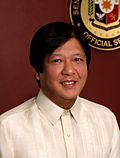| Rank | Image | Senator | Party | Voted at* | Date proclaimed | Religion | Prior congressional and elective executive positions | Born |
|---|
| 1st |  | Bong Revilla | | Lakas | Imus, Cavite | May 15, 2010 | Roman Catholicism | Senator (2004–2010), Governor of Cavite (1998–2001), Vice Governor of Cavite (1992–1998) | 1966 |
| 2nd |  | Jinggoy Estrada | | PMP | San Juan | May 15, 2010 | Roman Catholicism | Senator (2004–2010), Mayor of San Juan (1992–2001), Vice Mayor of San Juan (1988–1992) | 1963 |
| 3rd |  | Miriam Defensor Santiago | | PRP | Quezon City | May 15, 2010 | Roman Catholicism | Senator (1995–2001, 2004–2010) | 1945 |
| 4th |  | Franklin Drilon | | Liberal | Iloilo City | May 15, 2010 | Roman Catholicism | Senator (1995–2007; Senate President, 2000, 2001–2004) | 1945 |
| 5th |  | Juan Ponce Enrile | | PMP | Aparri Cagayan | May 15, 2010 | Roman Catholicism | Senator (1987–1992, 1995–2001, 2004–2010; Senate President, 2008–2010), member of the House of Representatives from Cagayan's 1st district (1992–1995), Member of the Batasang Pambansa from Region II (1978–1984), and from Cagayan's at-large district (1984–1986) | 1924 |
| 6th |  | Pia Cayetano | | Nacionalista | Taguig | May 15, 2010 | Evangelical Christianity | Senator (2004–2010) | 1966 |
| 7th |  | Bongbong Marcos | | Nacionalista | Batac, Ilocos Norte | May 15, 2010 | Roman Catholicism | Member of the House of Representatives from Ilocos Norte's 2nd district (1992–1995, 2007–2010), Governor of Ilocos Norte (1983–1986, 1998–2007) | 1957 |
| 8th |  | Ralph Recto | | Liberal | Lipa, Batangas | May 15, 2010 | Roman Catholicism | Senator (2001–2007), member of the House of Representatives from Batangas' 4th district (1992–2001) | 1964 |
| 9th |  | Tito Sotto | | NPC | Quezon City | May 15, 2010 | Roman Catholicism | Senator (1992–2004), Vice Mayor of Quezon City (1988–1992) | 1948 |
| 10th |  | Serge Osmeña | | Independent | Makati | May 18, 2010 | Roman Catholicism | Senator (1995–2007) | 1943 |
| 11th |  | Lito Lapid | | Lakas | Porac, Pampanga | May 18, 2010 | Roman Catholicism | Senator (2004–2010), Governor of Pampanga (1995–2004), Vice Governor of Pampanga (1992–1995) | 1955 |
| 12th |  | TG Guingona | | Liberal | Malaybalay, Bukidnon | May 18, 2010 | Roman Catholicism | Member of the House of Representatives from Bukidnon's 2nd district (2004–2010) | 1959 |













